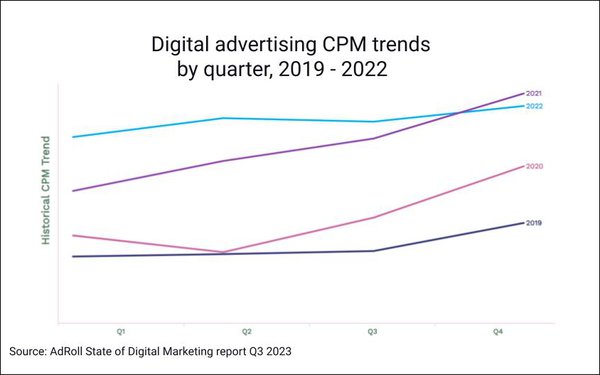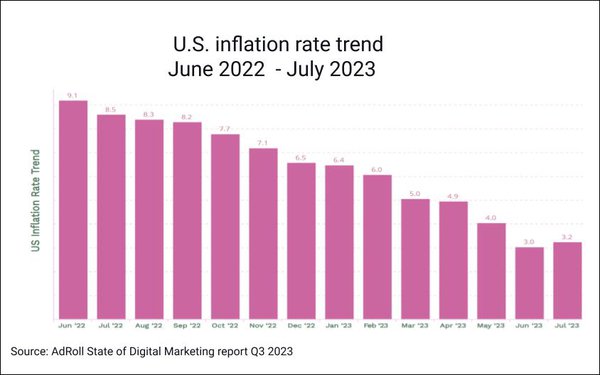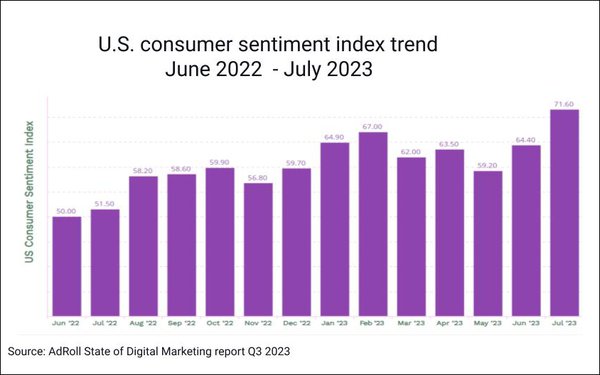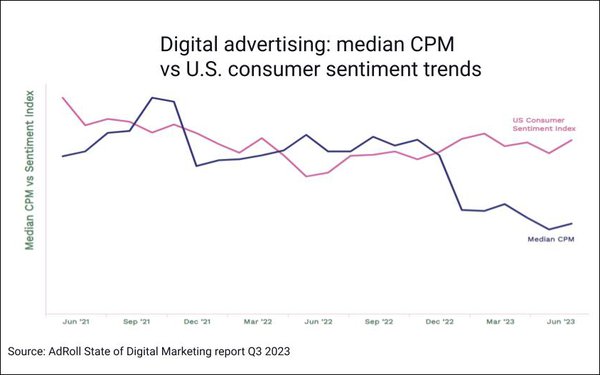
Digital advertising CPMs dropped by 49%
year-over-year, on average, according to AdRoll data from 2,000 online businesses in North America spanning finance, beauty and fashion, fitness, technology, travel and other industries.
That follows a 33% decline in YoY average CPM in this year’s first quarter, and a significant departure from the past two years, when average CPM increased between Q1 and Q2.

However, website traffic, while lower than in Q1,
showed a moderate YoY gain of 8% in Q2, and has been relatively stable for three years.

advertisement
advertisement
Further, online conversions (purchases or other industry-relevant events) were up
13% YoY in Q2, extending a gain in Q1. Conversion trends varied significantly by industry — with career, entertainment and hobbies among the biggest gainers and automotive and real estate
among the biggest losers, showing that while consumers are still somewhat reluctant to spring for big-ticket items, they are increasingly willing to spend on products or services that enrich their
daily lives or improve their job/career outlooks, notes AdRoll.

Further, while adverting demand, and so median CPM costs, have been declining
year-to-date in response to consumer spending pullbacks, significant improvements in the U.S. economy and consumer sentiment trends — combined with the historical trend of CPMs rising in Q3 and
peaking in Q4 — mean that “it’s not a matter of whether CPM will increase later this year, but by how much,” the report points out.

The U.S. inflation rate has dropped from 9.1% in June 2022 to 3.2% in
July — the lowest point since April 2021.

Consumer sentiment has shot up as inflation has been greatly reduced, the S&P 500 index has hit about 4,500 (the highest in 18 months), and Goldman Sachs and others are now predicting a high probability of
avoiding recession. In fact, sentiment is at 71.6 — the highest level in nearly two years.

And median CPMs closely follow consumer sentiment trends:

With consumer spending
likely to bounce back significantly heading into the holiday season, advertising demand and CPMs will quite possibly see not just gains but large and rapid gains in the second half.
Early signs of a digital advertising rebound include Meta’s strong ad revenue growth in Q2 and positive guidance for Q3 and advertising analysts’ recently more optimistic outlooks for
2H.
”Advertisers should leverage this period when advertising costs are low to reach out to their high-value consumers, who may be different from those prior to the
pandemic,” suggests Vibhor Kapoor, president of AdRoll. “They should then develop marketing campaigns to generate brand awareness and loyalty that can carry through to maximize revenues
during what’s predicted to be a $1.328 trillion holiday shopping season of 2023.”
Once ad spending has increased during the holidays, marketers should focus on conversion-driving
campaigns, such as retargeting and abandoned cart recovery, to maximize return on ad spend, he adds.